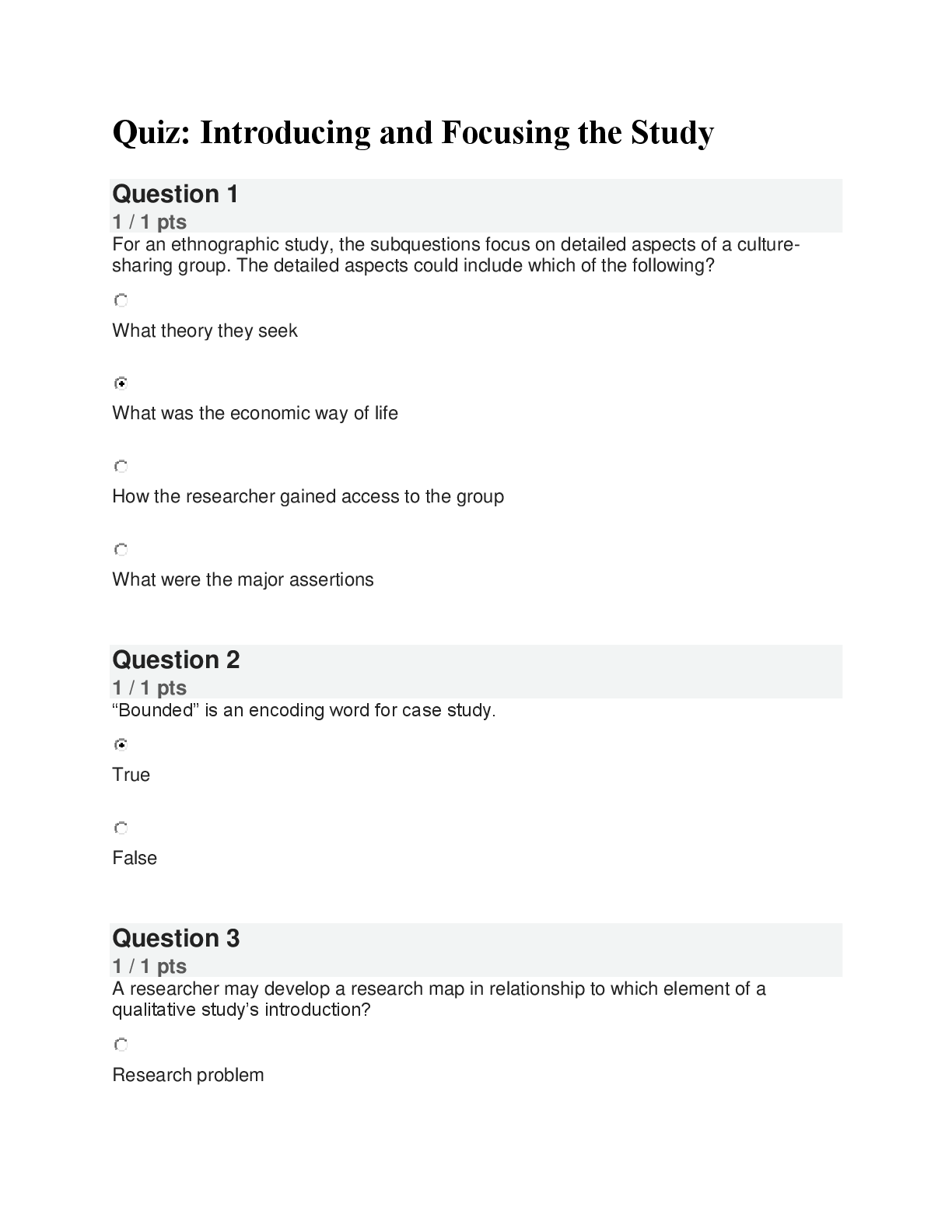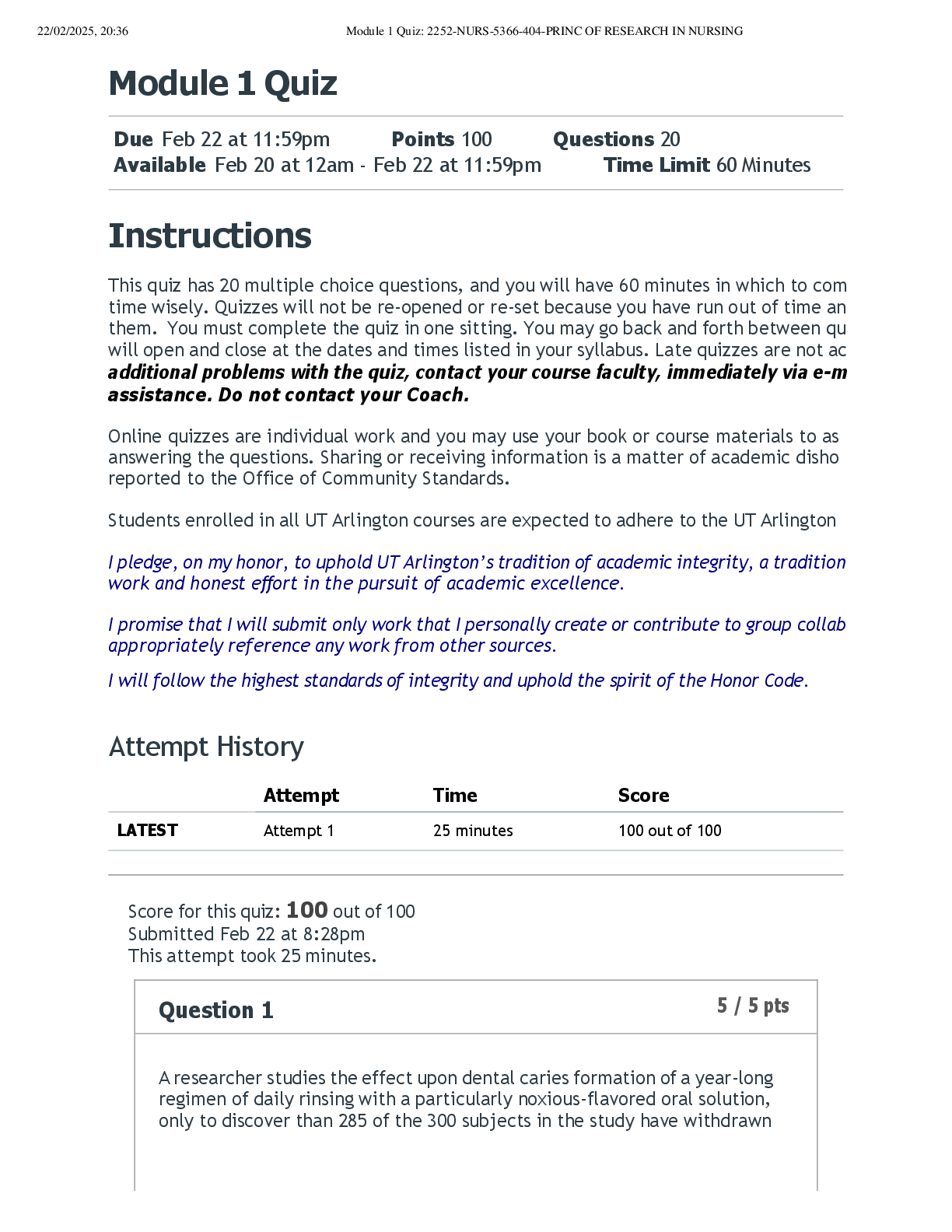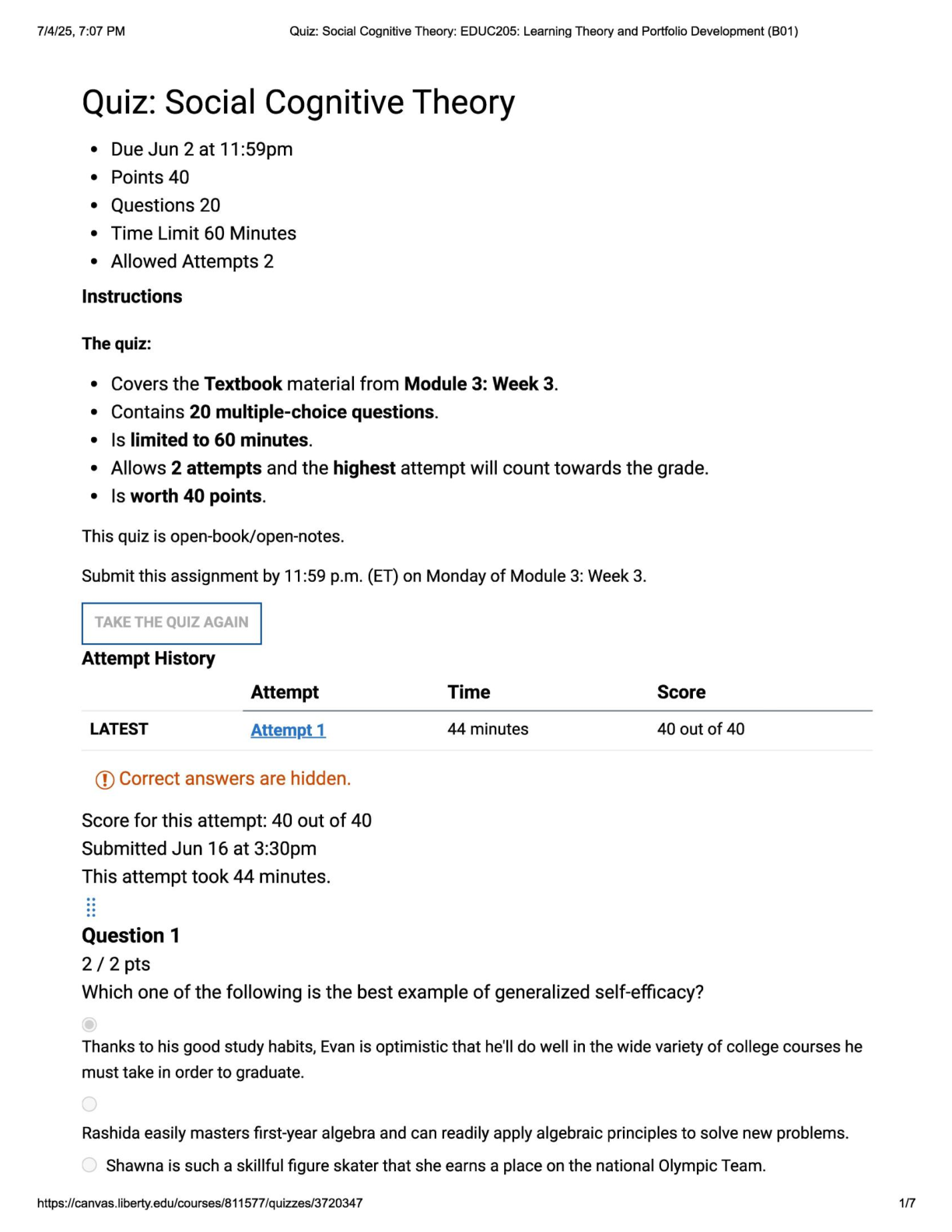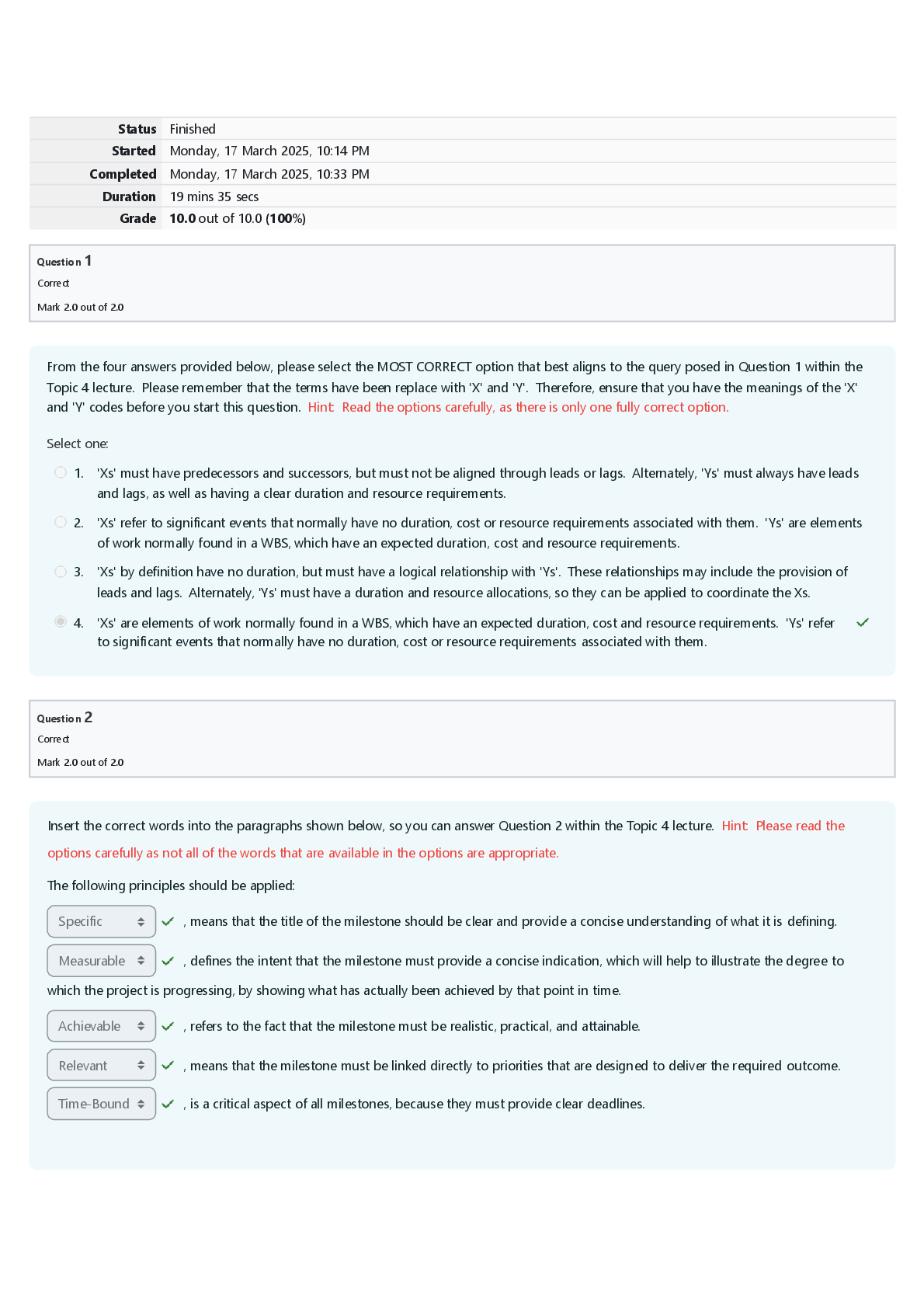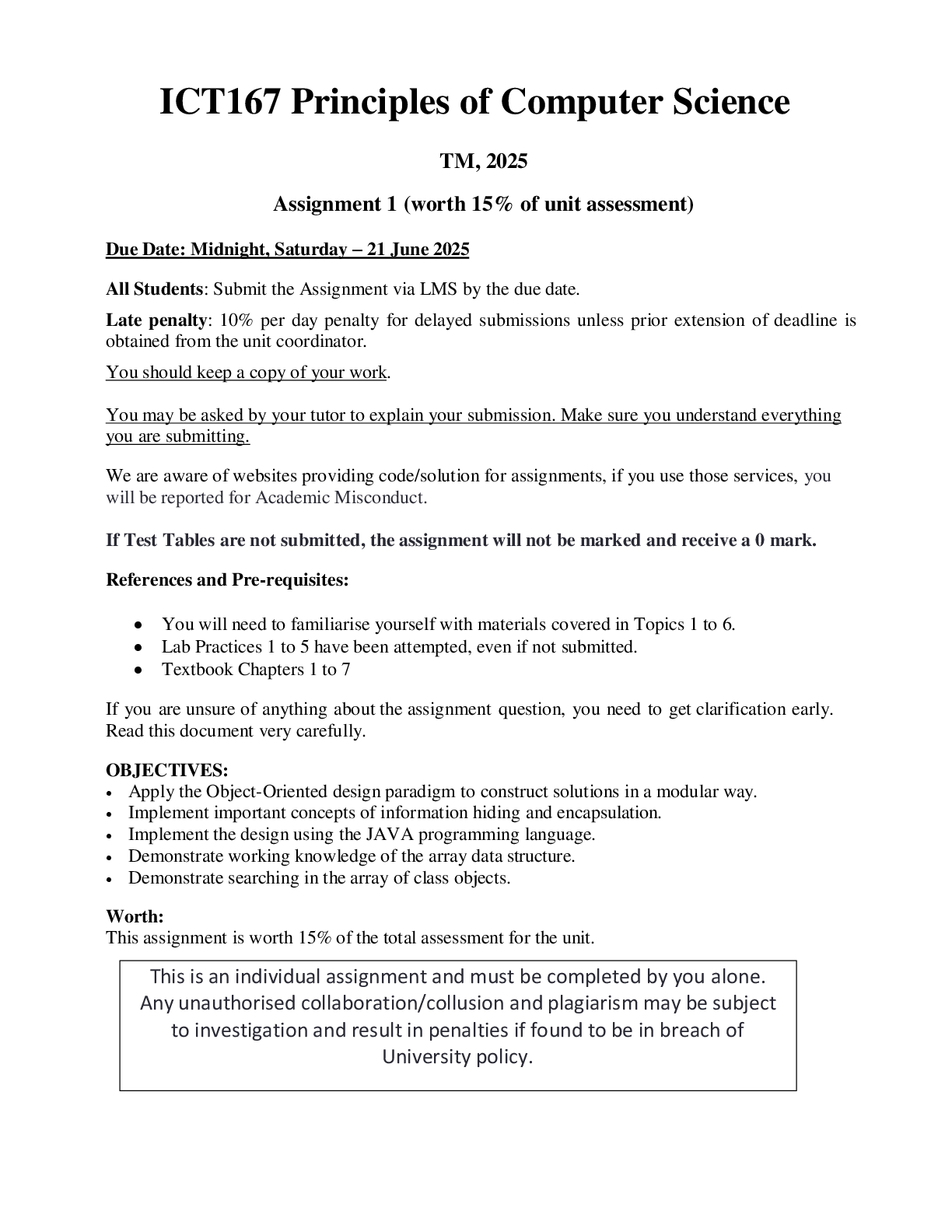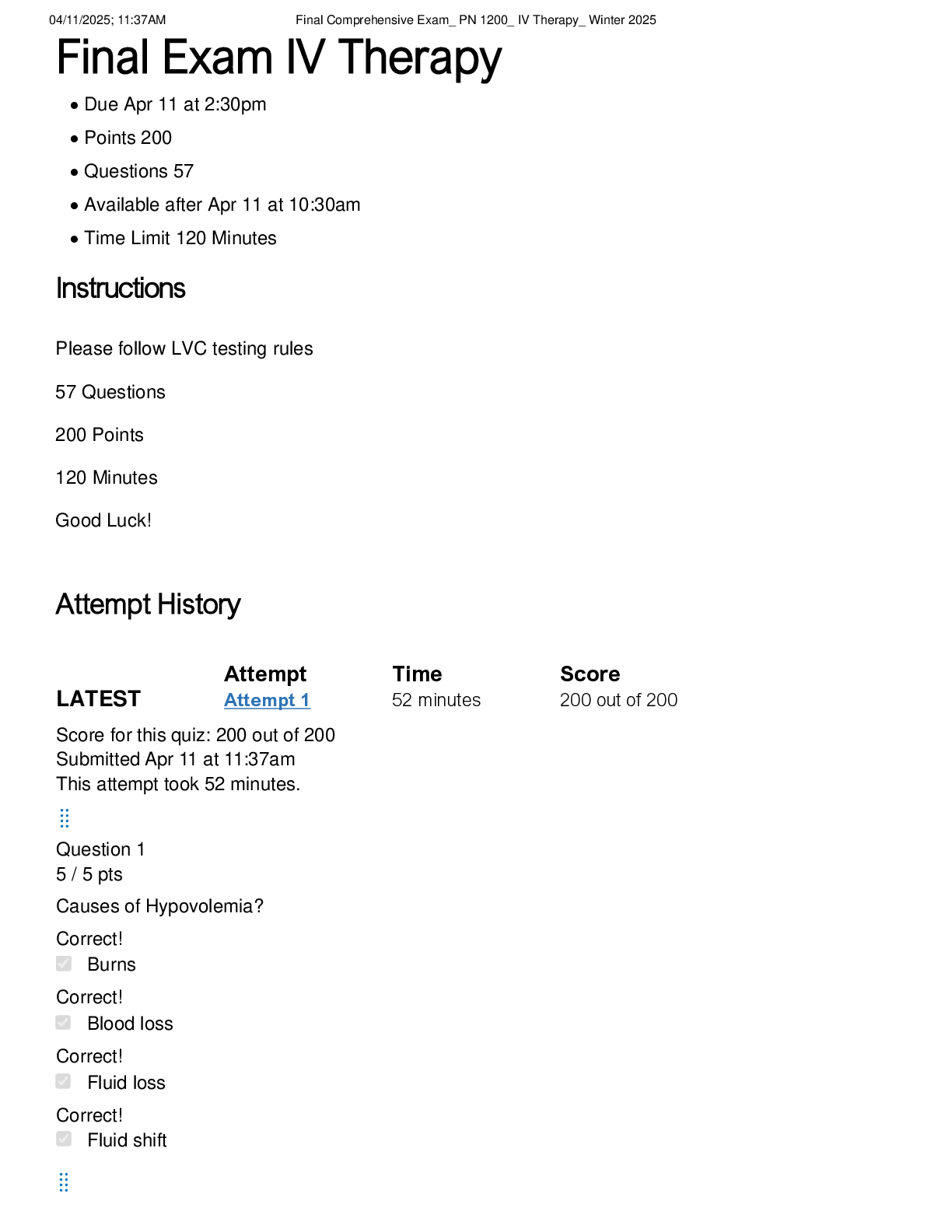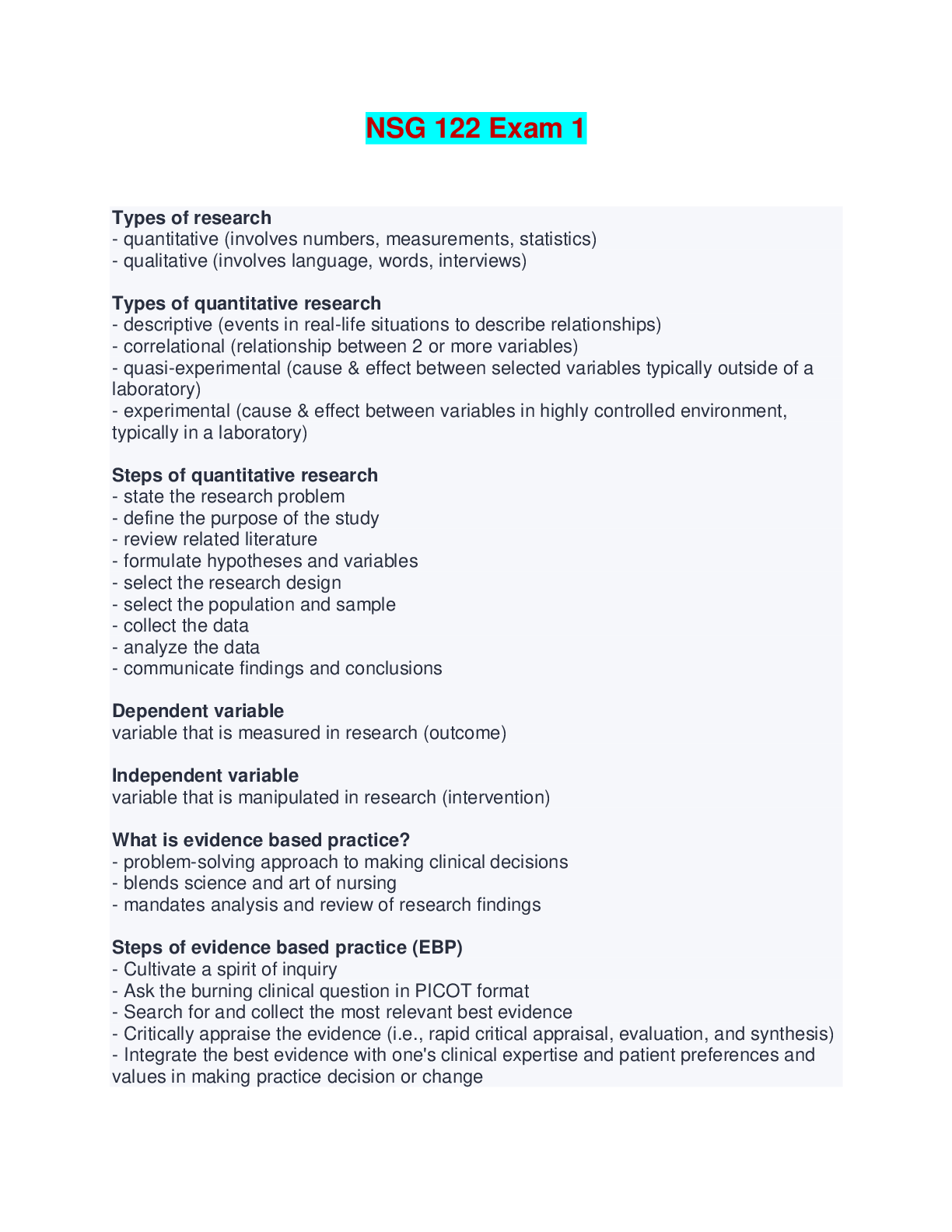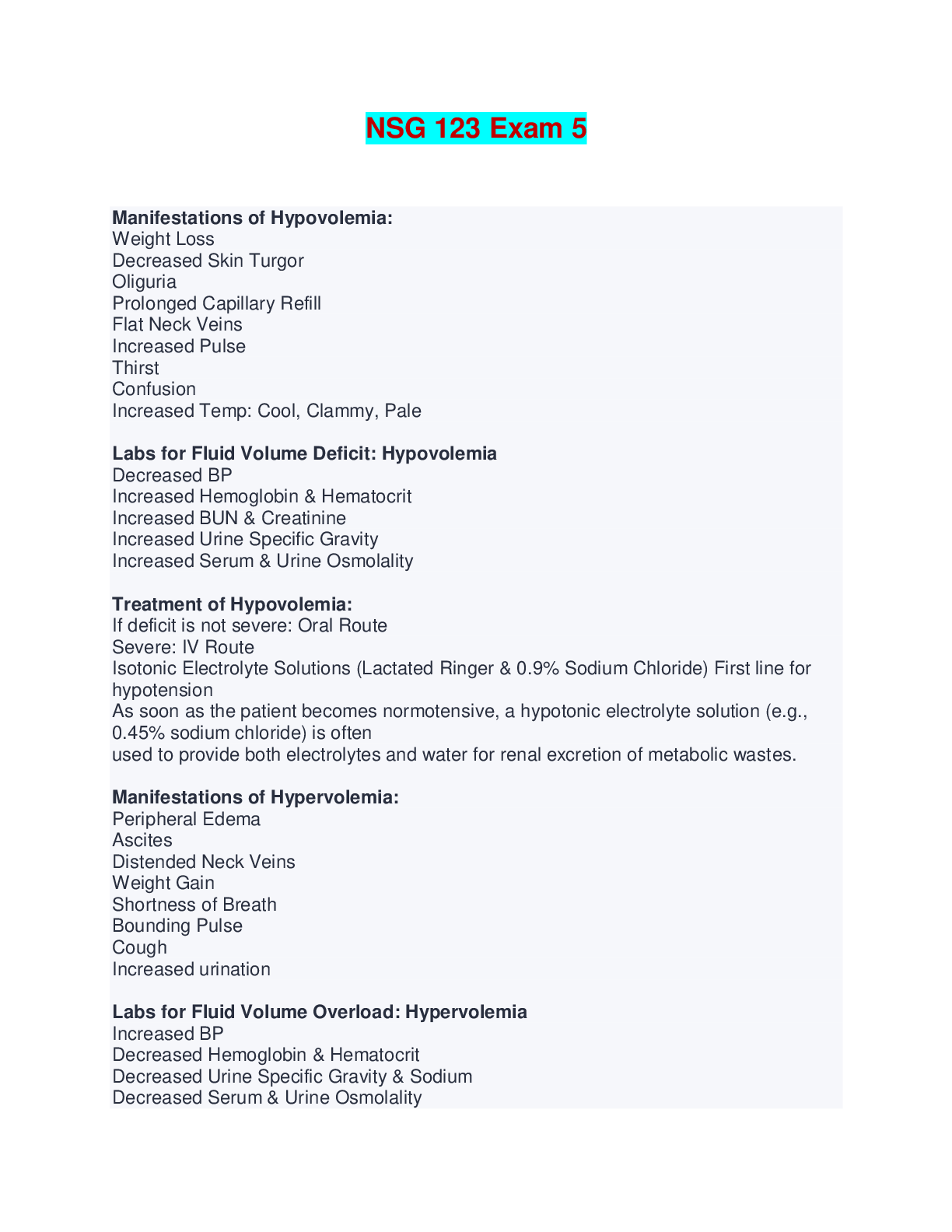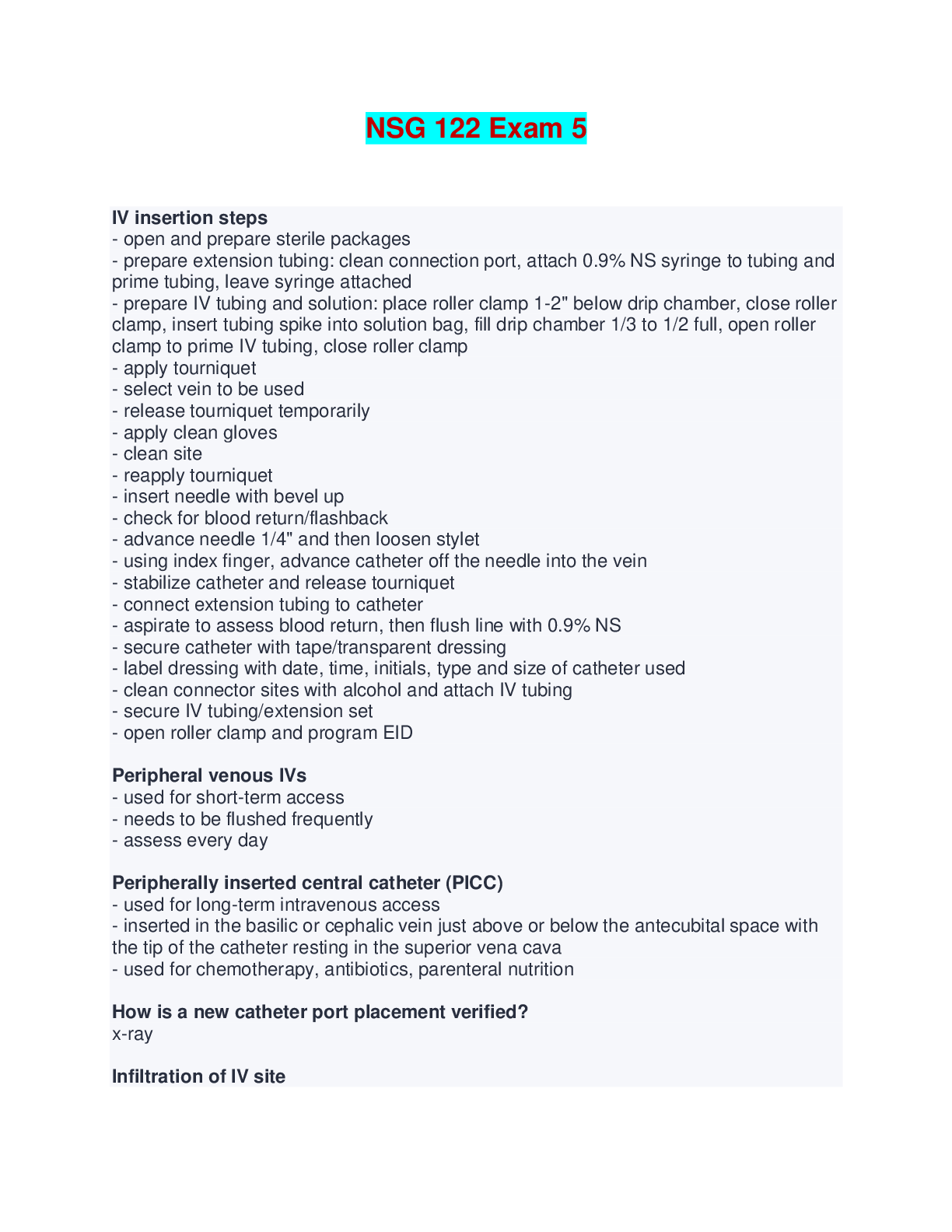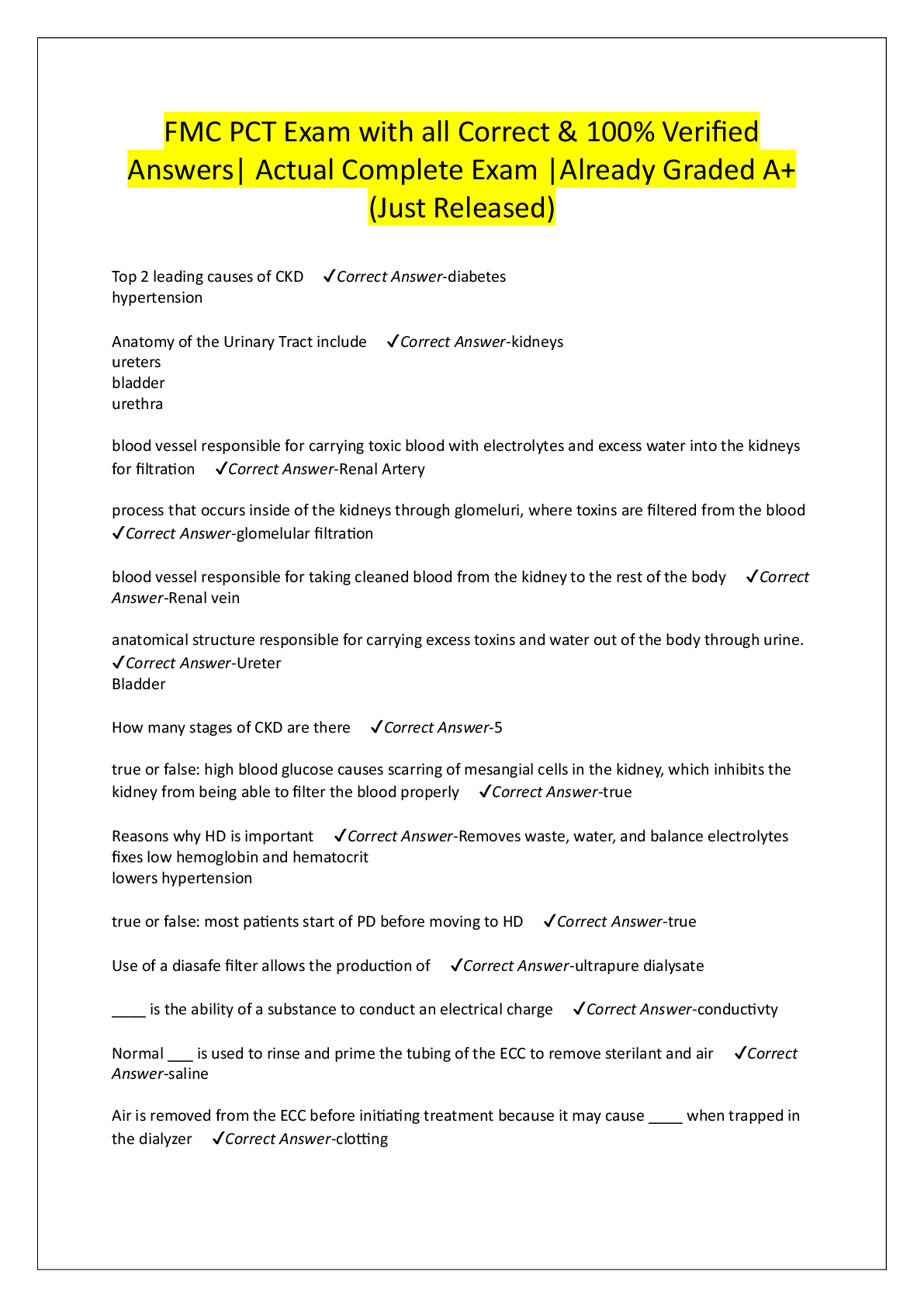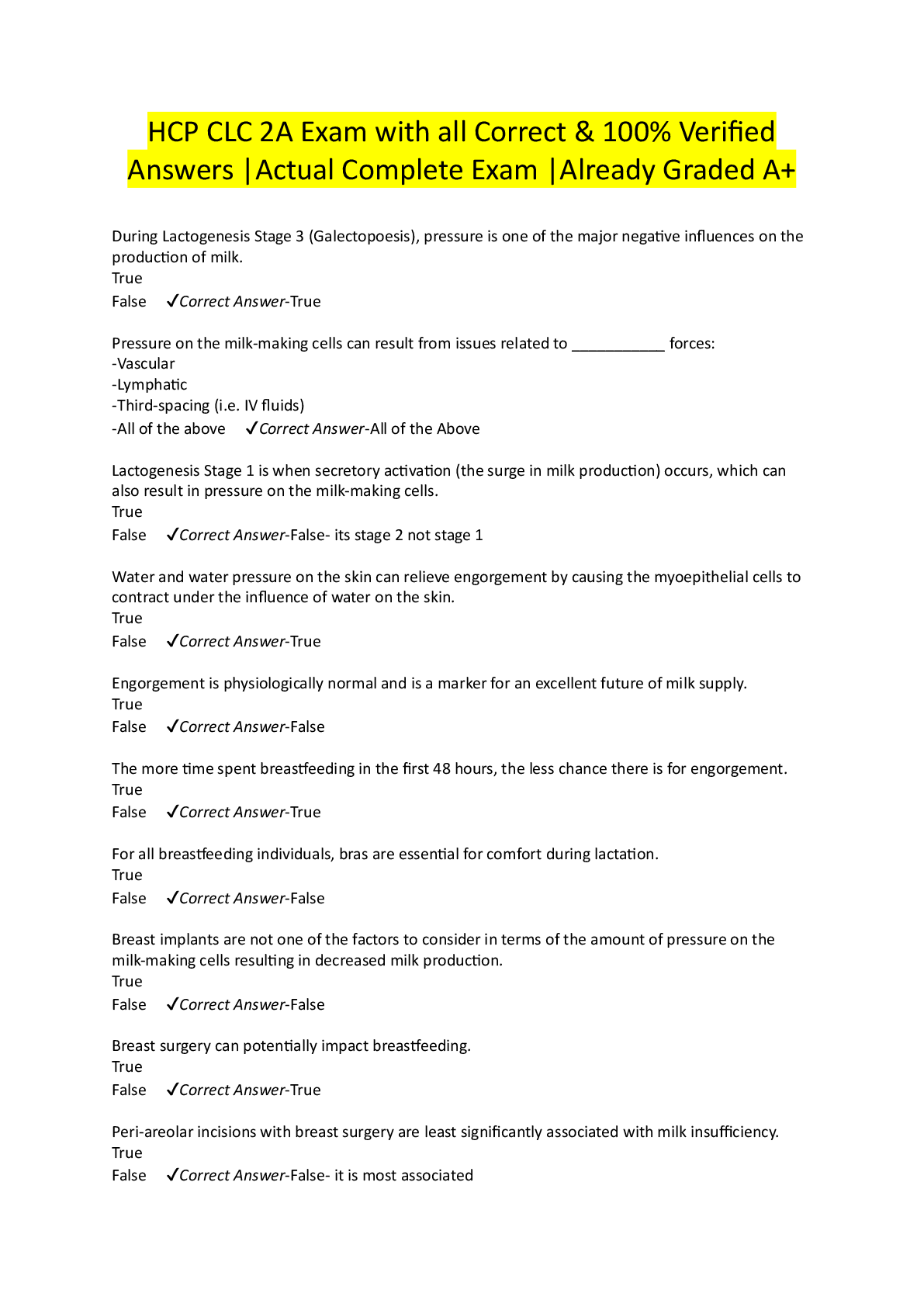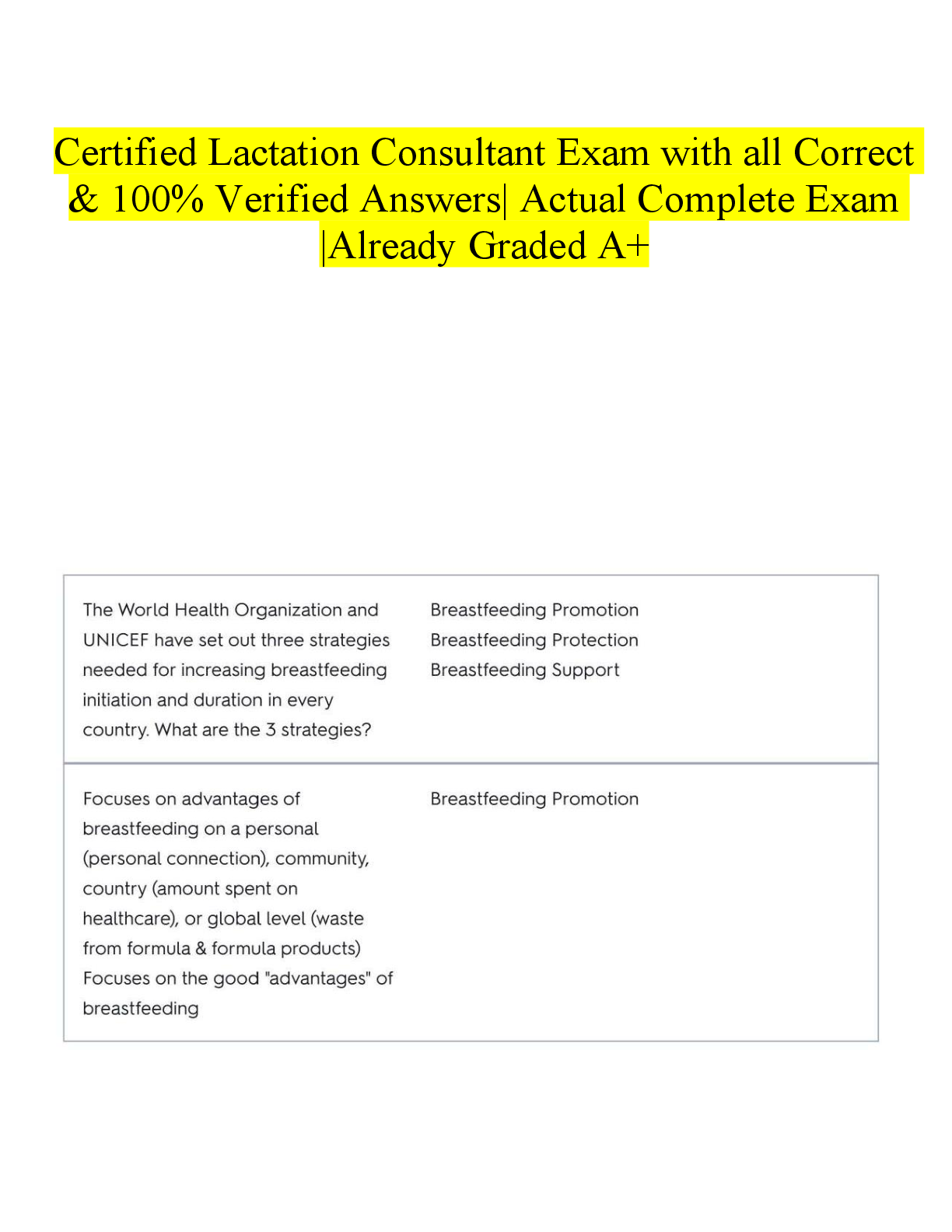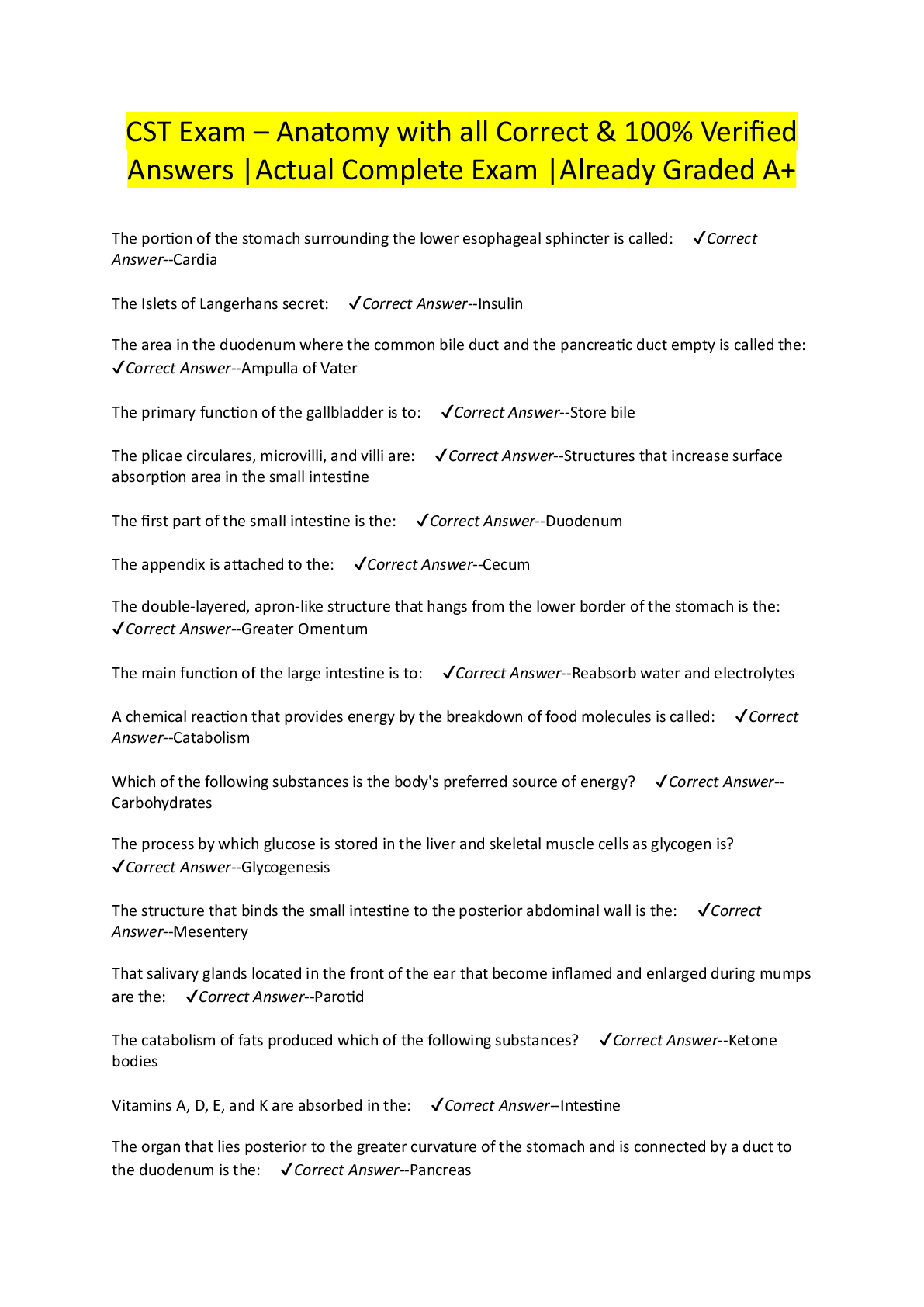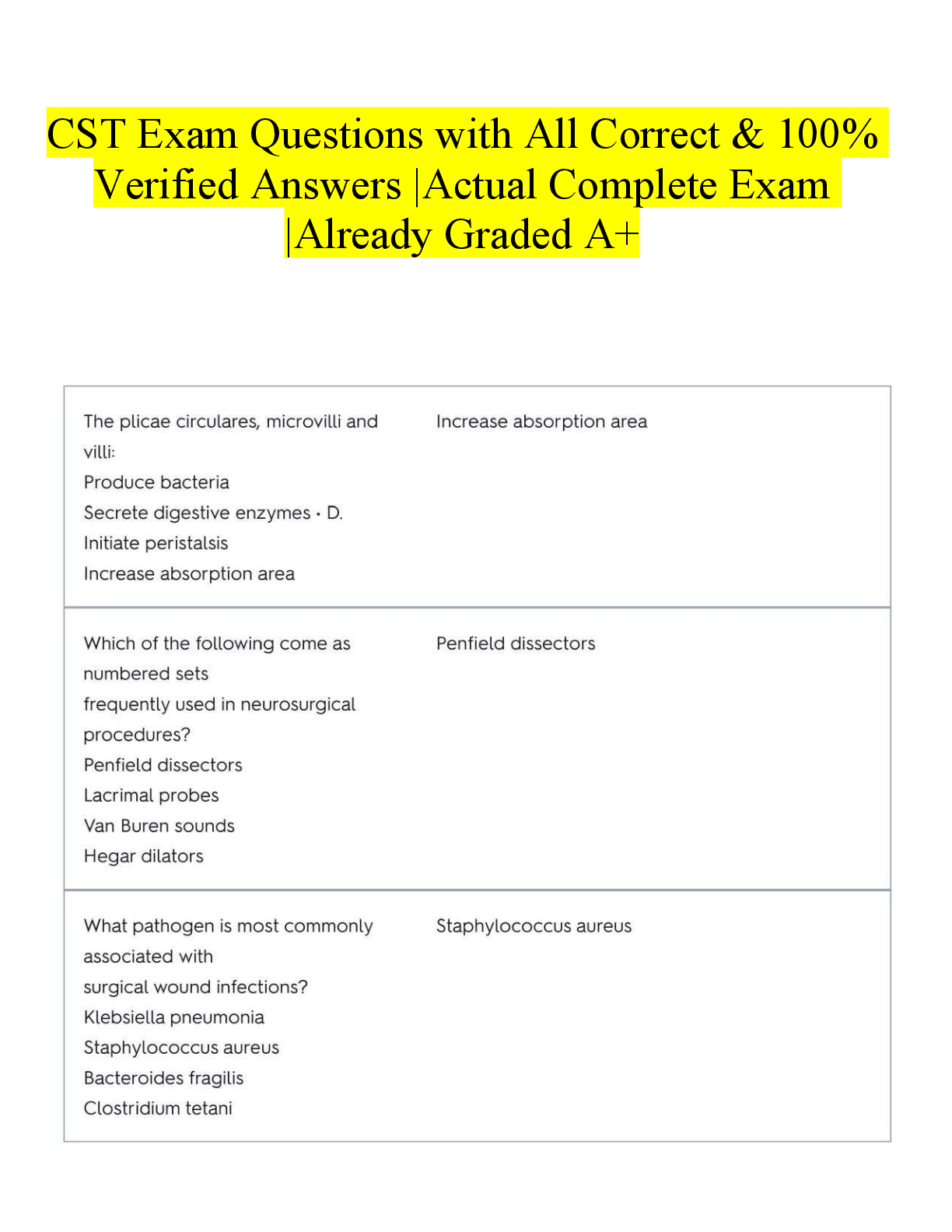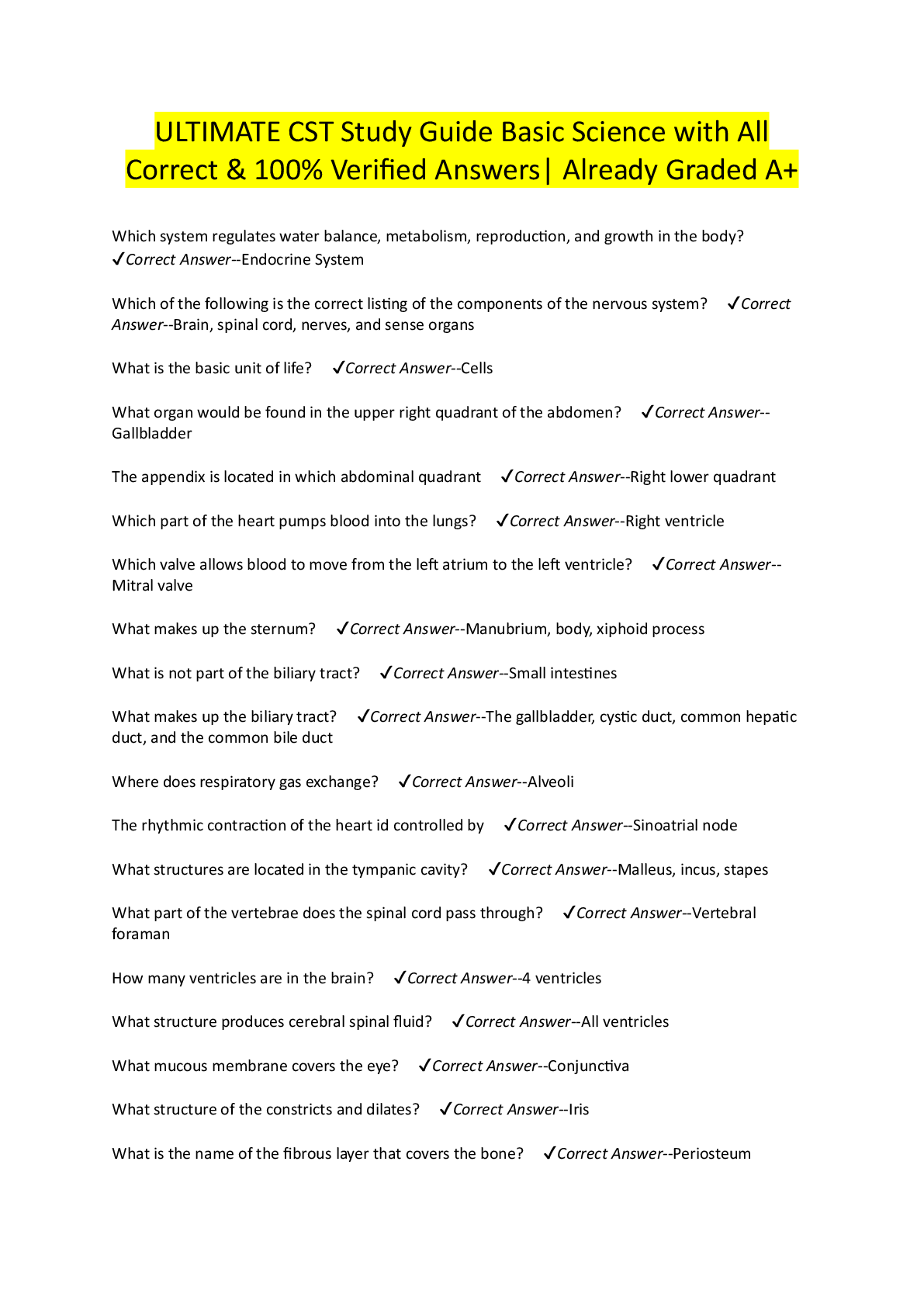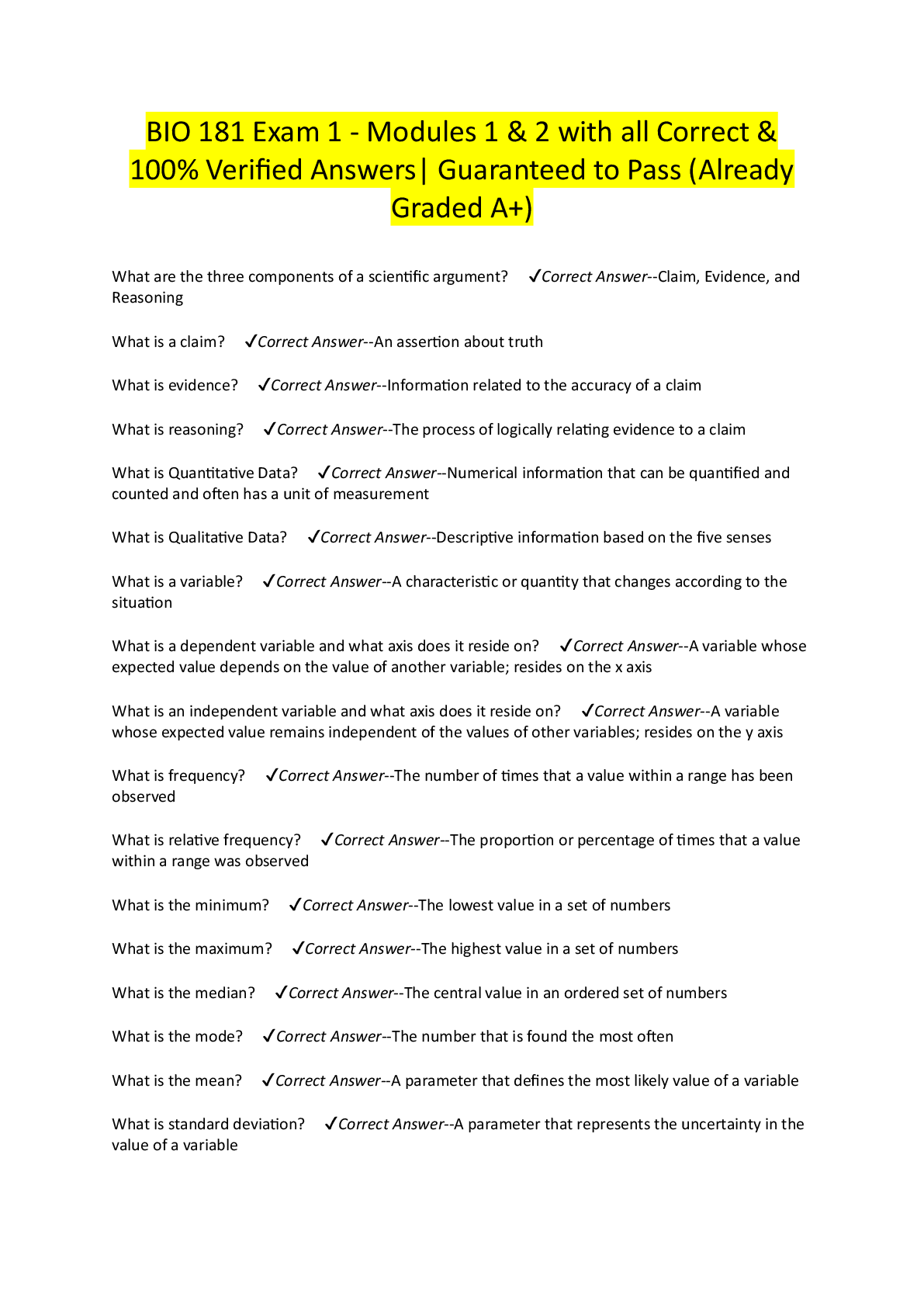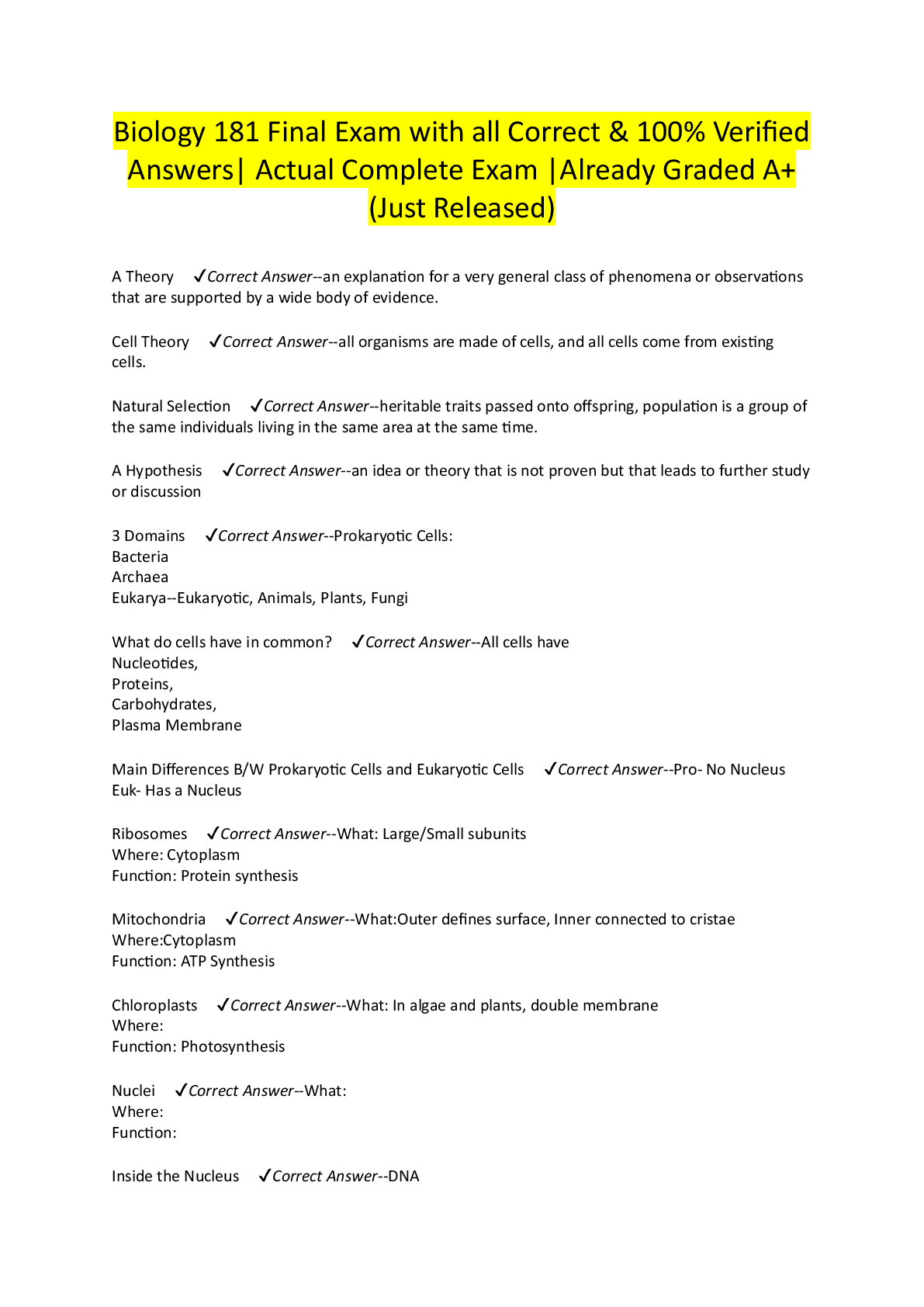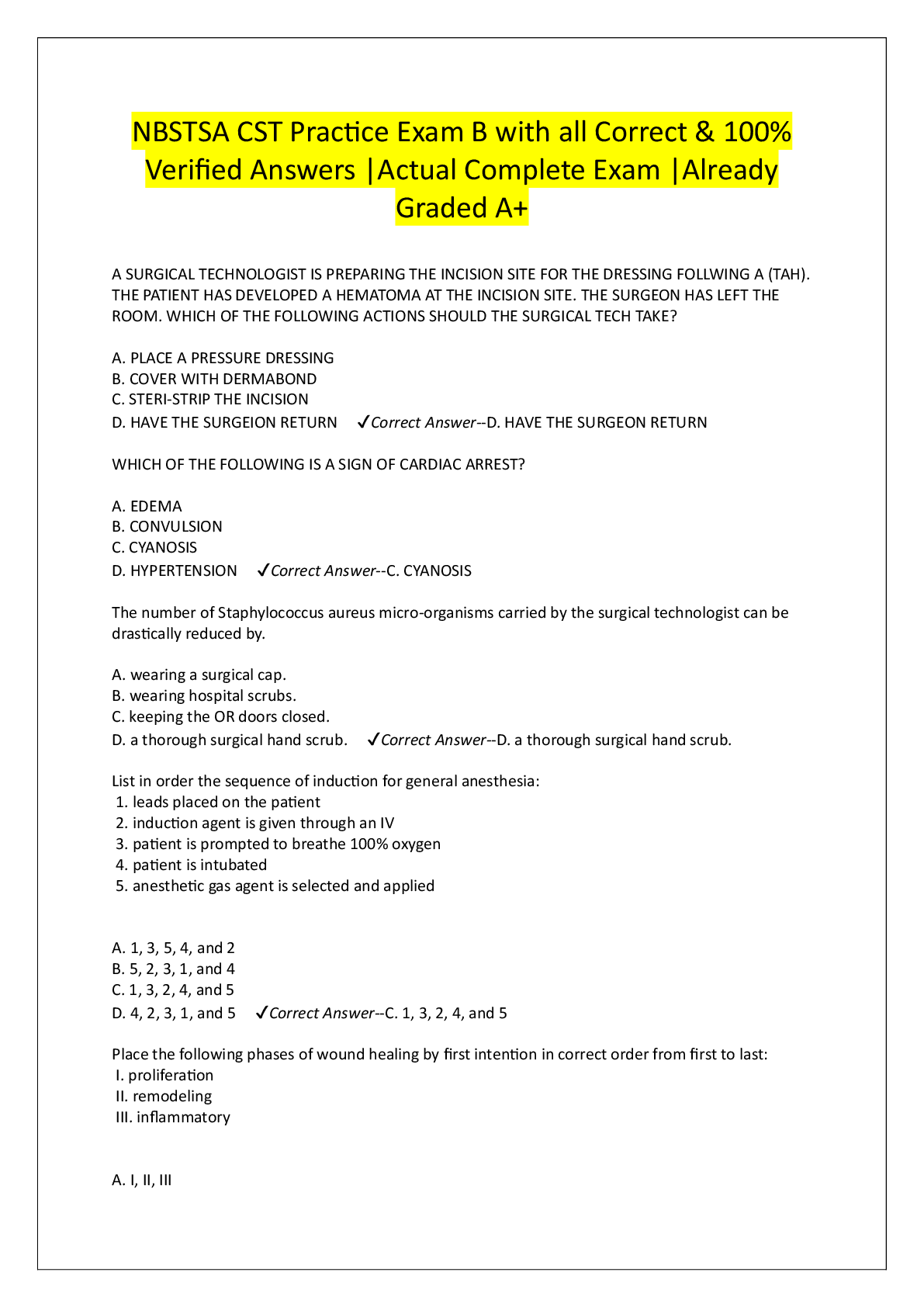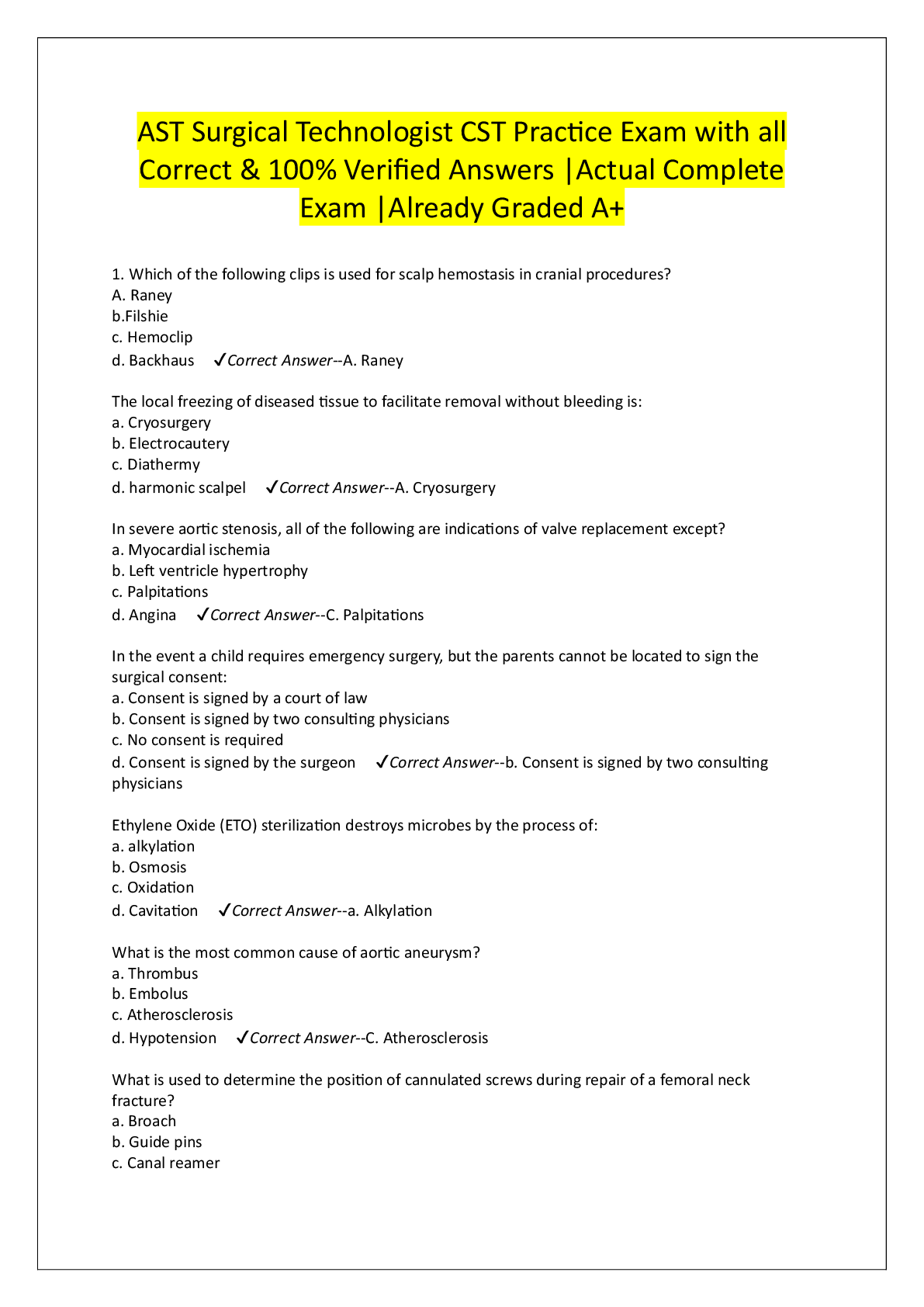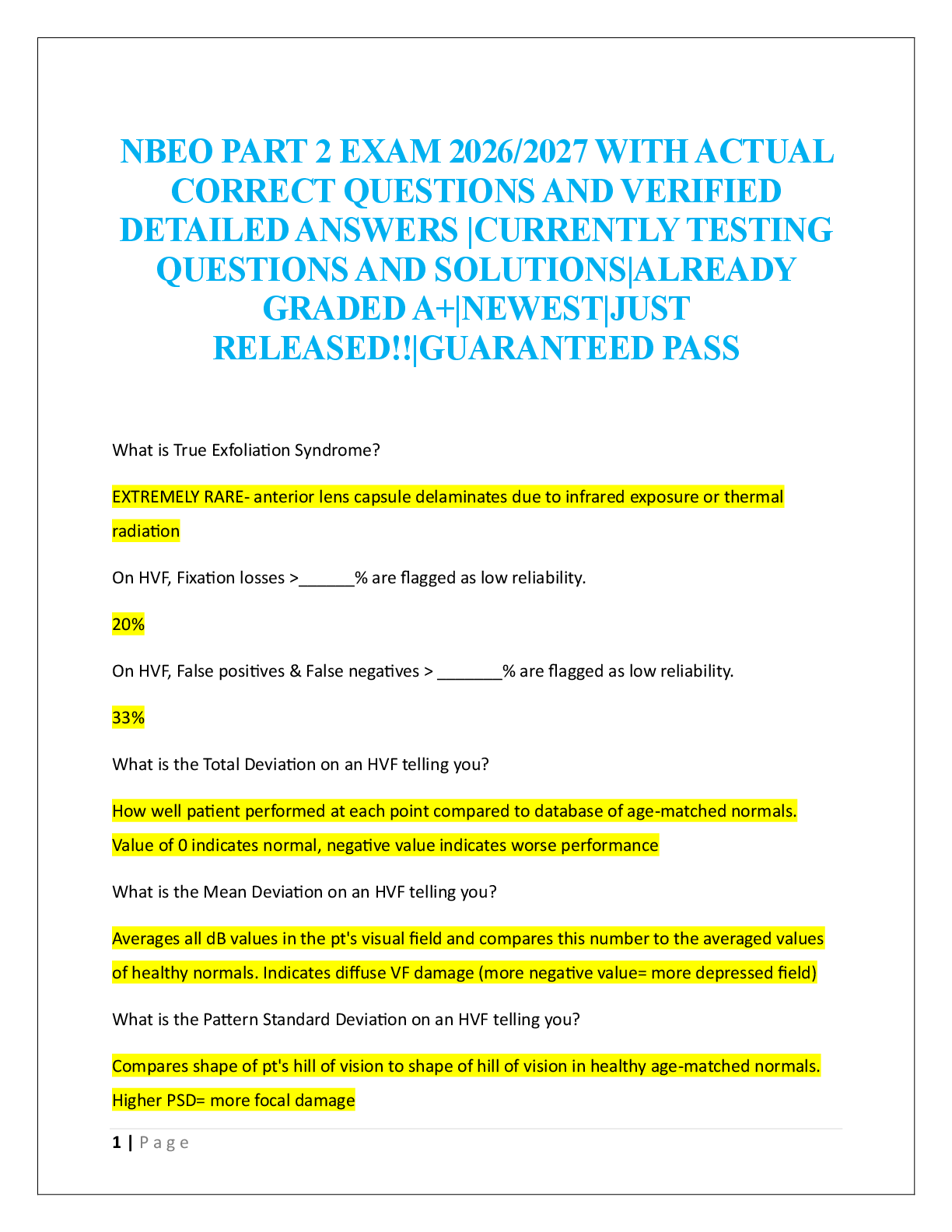c12 CNURSING 295 - Questions and Answers (Latest Version)
Document Content and Description Below
N295 ch 12 MULTIPLE CHOICE 1. The nurse educator is preparing an education module for the nursing staff on the epidermal layer of skin. Which of these statements would be included in the modu ... le? The epidermis is: 2. The nurse educator is preparing an education module for the nursing staff on the dermis layer of skin. Which of these statements would be included in the module? The dermis: 3. The nurse is examining a patient who tells the nurse, “I sure sweat a lot, especially on my face and feet but it doesn’t have an odor.” The nurse knows that this condition could be related to: 4. A newborn infant is in the clinic for a well-baby checkup. The nurse observes the infant for the possibility of fluid loss because of which of these factors? 5. The nurse is bathing an 80-year-old man and notices that his skin is wrinkled, thin, lax, and dry. This finding would be related to which factor in the older adult? 6. During the aging process, the hair can look gray or white and begin to feel thin and fine. The nurse knows that this occurs because of a decrease in the number of functioning: 7. During an examination, the nurse finds that a patient has excessive dryness of the skin. The best term to describe this condition is: 8. A 22-year-old woman comes to the clinic because of severe sunburn and states, “I was out in the sun for just a couple of minutes.” The nurse begins a medication review with her, paying special attention to which medication class? 9. A woman is leaving on a trip to Hawaii and has come in for a checkup. During the examination the nurse learns that she has diabetes and takes oral hypoglycemic agents. The patient needs to be concerned about which possible effect of her medications? 10. A 13-year-old girl is interested in obtaining information about the cause of her acne. The nurse should share with her that acne: 11. A 75-year-old woman who has a history of diabetes and peripheral vascular disease has been trying to remove a corn on the bottom of her foot with a pair of scissors. The nurse will encour-age her to stop trying to remove the corn with scissors because: 12. The nurse keeps in mind that a thorough skin assessment is extremely important because the skin holds information about a person’s: 13. A patient comes in for a physical examination and complains of “freezing to death” while waiting for her examination. The nurse notes that her skin is pale and cool and attributes this finding to: 14. A patient comes to the clinic and tells the nurse that he has been confined to his recliner chair for approximately 3 days with his feet down and he asks the nurse to evaluate his feet. During the assessment, the nurse might expect to find: 15. A patient is especially worried about an area of skin on her feet that has turned white. The health care provider has told her that her condition is vitiligo. The nurse explains to her that vitiligo is: 16. A patient tells the nurse that he has noticed that one of his moles has started to burn and bleed. When assessing his skin, the nurse pays special attention to the danger signs for pigmented le-sions and is concerned with which additional finding? 17. A patient comes to the clinic and states that he has noticed that his skin is redder than normal. The nurse understands that this condition is due to hyperemia and knows that it can be caused by: 18. During a skin assessment, the nurse notices that a Mexican-American patient has skin that is yellowish-brown; however, the skin on the hard and soft palate is pink and the patient’s scleras are not yellow. From this finding, the nurse could probably rule out: 19. A black patient is in the intensive care unit because of impending shock after an accident. The nurse expects to find what characteristics in this patient’s skin? 20. An older adult woman is brought to the emergency department after being found lying on the kitchen floor for 2 days; she is extremely dehydrated. What would the nurse expect to see during the examination? 21. A 42-year-old woman complains that she has noticed several small, slightly raised, bright red dots on her chest. On examination, the nurse expects that the spots are probably: 22. A 65-year-old man with emphysema and bronchitis has come to the clinic for a follow-up appointment. On assessment, the nurse might expect to see which finding? 23. A newborn infant has Down syndrome. During the skin assessment, the nurse notices a transient mottling in the trunk and extremities in response to the cool temperature in the examination room. The infant’s mother also notices the mottling and asks what it is. The nurse knows that this mott-ling is called: 24. A 35-year-old pregnant woman comes to the clinic for a monthly appointment. During the assessment, the nurse notices that she has a brown patch of hyperpigmentation on her face. The nurse continues the skin assessment aware that another finding may be: 25. A man has come in to the clinic for a skin assessment because he is worried he might have skin cancer. During the skin assessment the nurse notices several areas of pigmentation that look greasy, dark, and “stuck on” his skin. Which is the best prediction? 26. A 70-year-old woman who loves to garden has small, flat, brown macules over her arms and hands. She asks, “What causes these liver spots?” The nurse tells her, “They are: 27. The nurse notices that a patient has a solid, elevated, circumscribed lesion that is less than 1 cm in diameter. When documenting this finding, the nurse reports this as a: 28. The nurse just noted from the medical record that the patient has a lesion that is confluent in nature. On examination, the nurse expects to find: 29. A patient has had a “terrible itch” for several months that he has been continuously scratching. On examination, the nurse might expect to find: 30. A physician has diagnosed a patient with purpura. After leaving the room, a nursing student asks the nurse what the physician saw that led to that diagnosis. The nurse should say, “The physician is referring to the: 31. A mother has noticed that her son, who has been to a new babysitter, has some blisters and scabs on his face and buttocks. On examination, the nurse notices moist, thin-roofed vesicles with a thin erythematous base and suspects: 32. The nurse notices that a school-aged child has bluish-white, red-based spots in her mouth that are elevated approximately 1 to 3 mm. What other signs would the nurse expect to find in this pa-tient? 33. The nurse is assessing the skin of a patient who has acquired immunodeficiency syndrome (AIDS) and notices multiple patchlike lesions on the temple and beard area that are faint pink in color. The nurse recognizes these lesions as: 34. A 45-year-old farmer comes in for a skin evaluation and complains of hair loss on his head. His hair seems to be breaking off in patches, and he notices some scaling on his head. The nurse be-gins the examination suspecting: 35. A mother brings her child into the clinic for an examination of the scalp and hair. She states that the child has developed irregularly shaped patches with broken-off, stublike hair in some places; she is worried that this condition could be some form of premature baldness. The nurse tells her that it is: 36. The nurse has discovered decreased skin turgor in a patient and knows that this finding is expected in which condition? 37. While performing an assessment of a 65-year-old man with a history of hypertension and coronary artery disease, the nurse notices the presence of bilateral pitting edema in the lower legs. The skin is puffy and tight but normal in color. No increased redness or tenderness is observed over his lower legs, and the peripheral pulses are equal and strong. In this situation, the nurse suspects that the likely cause of the edema is which condition? 38. A 40-year-old woman reports a change in mole size, accompanied by color changes, itching, burning, and bleeding over the past month. She has a dark complexion and has no family history of skin cancer, but she has had many blistering sunburns in the past. The nurse would: 39. The nurse is assessing for clubbing of the fingernails and expects to find: 40. The nurse is assessing a patient who has liver disease for jaundice. Which of these assessment findings is indicative of true jaundice? 41. The nurse is assessing for inflammation in a dark-skinned person. Which technique is the best? 42. A few days after a summer hiking trip, a 25-year-old man comes to the clinic with a rash. On examination, the nurse notes that the rash is red, macular, with a bull’s eye pattern across his midriff and behind his knees. The nurse suspects: 43. A 52-year-old woman has a papule on her nose that has rounded, pearly borders and a central red ulcer. She said she first noticed it several months ago and that it has slowly grown larger. The nurse suspects which condition? 44. A father brings in his 2-month-old infant to the clinic because the infant has had diarrhea for the last 24 hours. He says his baby has not been able to keep any formula down and that the diarrhea has been at least every 2 hours. The nurse suspects dehydration. The nurse should test skin mobil-ity and turgor over the infant’s: 45. A semiconscious woman is brought to the emergency department after she was found on the floor in her kitchen. Her face, nail beds, lips, and oral mucosa are a bright cherry-red color. The nurse suspects that this coloring is due to: 46. A patient has been admitted for severe psoriasis. The nurse expects to see what finding in the patient’s fingernails? MULTIPLE RESPONSE 1. The nurse is preparing for a certification course in skin care and needs to be familiar with the various lesions that may be identified on assessment of the skin. Which of the following defini-tions are correct? Select all that apply. 2. A patient has been admitted to a hospital after the staff in the nursing home noticed a pressure ulcer in his sacral area. The nurse examines the pressure ulcer and determines that it is a stage II ulcer. Which of these findings are characteristic of a stage II pressure ulcer? Select all that apply. [Show More]
Last updated: 3 years ago
Preview 1 out of 16 pages
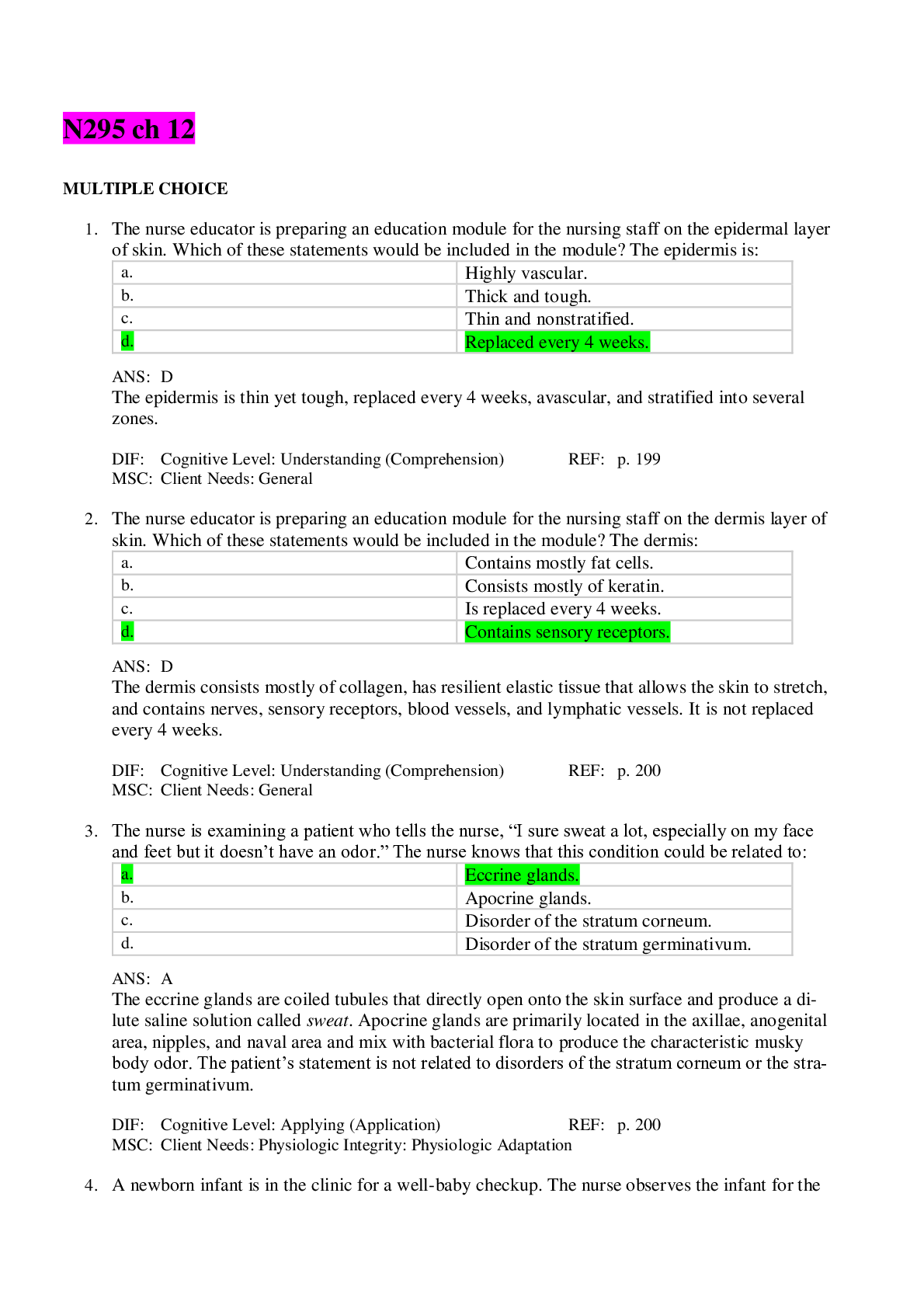
Buy this document to get the full access instantly
Instant Download Access after purchase
Buy NowInstant download
We Accept:

Also available in bundle (1)
Click Below to Access Bundle(s)

CNURSING 295
CHAPTER 23 NEUROLOGIC SYSTEM,CHAPTER 21 ABDOMINAL ASSESSMENT,N295 EXAM 4,N295 EXAM 3,c22,c21,c19,c18,c17,c16,c15,c14,c13,c12,c11,c10,c9,c8,c7,c6,c5,c4,c2,c1
By Ajay25 4 years ago
$75
24
Reviews( 0 )
$15.00
Can't find what you want? Try our AI powered Search
Document information
Connected school, study & course
About the document
Uploaded On
Jan 17, 2021
Number of pages
16
Written in
All
Additional information
This document has been written for:
Uploaded
Jan 17, 2021
Downloads
0
Views
131


